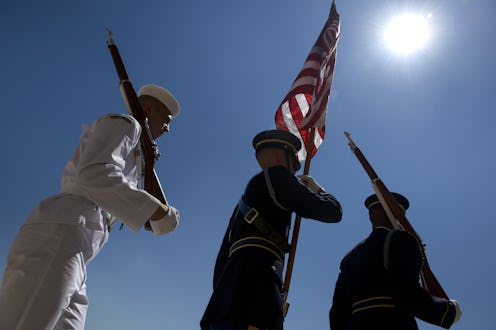News
When Will The Military Accept Transgender People?
Defense Secretary Ash Carter announced Monday that the military could lift its ban on transgender service members as early as six months from now. Branches will have the interim period to investigate the potential impacts of incorporating transgender service members and implement appropriate policies. Long overdue, this change is good news for an increasingly liberated segment of Americans — and for the rest of us on the home front — but it won't come without a unique set of challenges.
The ban on transgender service members has come under scrutiny recently, in large part thanks to Chelsea Manning. Manning, formerly known as Bradley, is a U.S. Army soldier convicted in 2013 of violating the Espionage Act by leaking classified information to WikiLeaks. She was sentenced to 35 years in prison. On the day after her sentencing, she announced through her attorney that she wished to undergo a gender reassignment transition and to be known as a woman. After much debate, the Army approved hormone therapy treatments for Manning — but it hasn't yet changed its official polices toward transgender people in general.
Under current policy, transgender people are considered ineligible to serve. If a member of the military is found to be transgender, he or she is at risk of being discharged, usually on a medical basis. But according to Monday's announcement, it could only take six months to change that.
Following the announcement, the Department of Defense will establish a working group to study the potential effects of lifting the ban and what it will take to get the troops ready. As it turns out, there are several logistical aspects of military life that will need to be addressed. For instance, what uniform will a transgender person wear? At what point will he or she switch from a male uniform to a female uniform (or vice versa)? At what point will the individual switch barracks?
The DOD seems eager to lift the ban. In fact, Carter's statement seems to imply that for the next six months, it's not a matter of whether or not transgender people will be permitted to serve, but rather an issue of preparedness.
At my direction, the working group will start with the presumption that transgender persons can serve openly without adverse impact on military effectiveness and readiness, unless and except where objective, practical impediments are identified.
This suggests that we could indeed see the ban lifted in six months. If history repeats itself, however, six months might not be an attainable timeline. Don't Ask, Don't Tell, the military's long-standing ban on gay people serving openly, was not officially lifted until September 2011, although legislation to lift the ban passed in December 2010. Under the legislation, Pentagon leaders had to train troops on the new policies and agree on their readiness before the ban could be officially repealed. Then, the issue had to return to Congress for a 60-day waiting period. All in all, the process took nearly 10 months.
In this case, an action by Congress isn't entirely necessary. Don't Ask, Don't Tell was a law passed by the Clinton administration, but the Obama administration has since clarified that the policy on transgender persons will stay or go at the discretion of the DOD. Hopefully, that will speed up the process and move the military forward as soon as possible.
Image: Getty Images (1)
